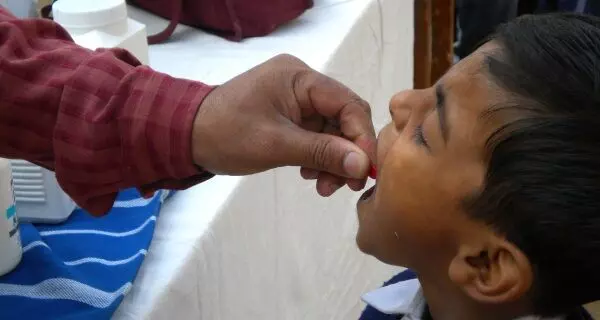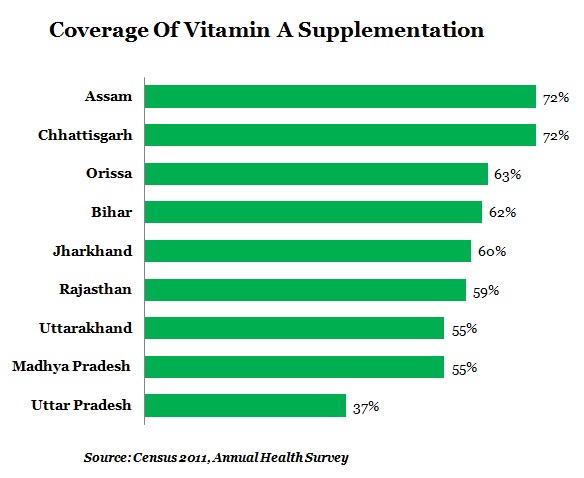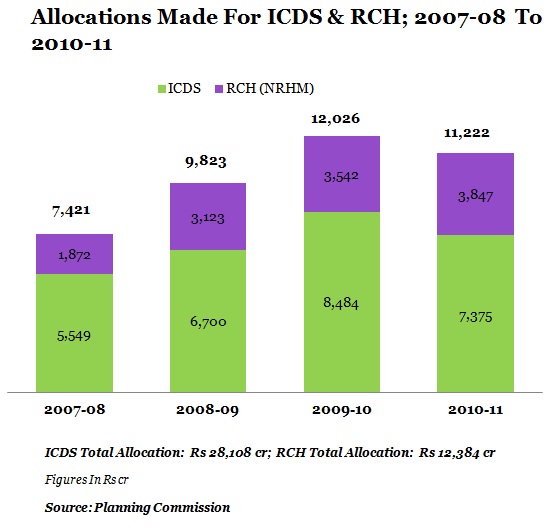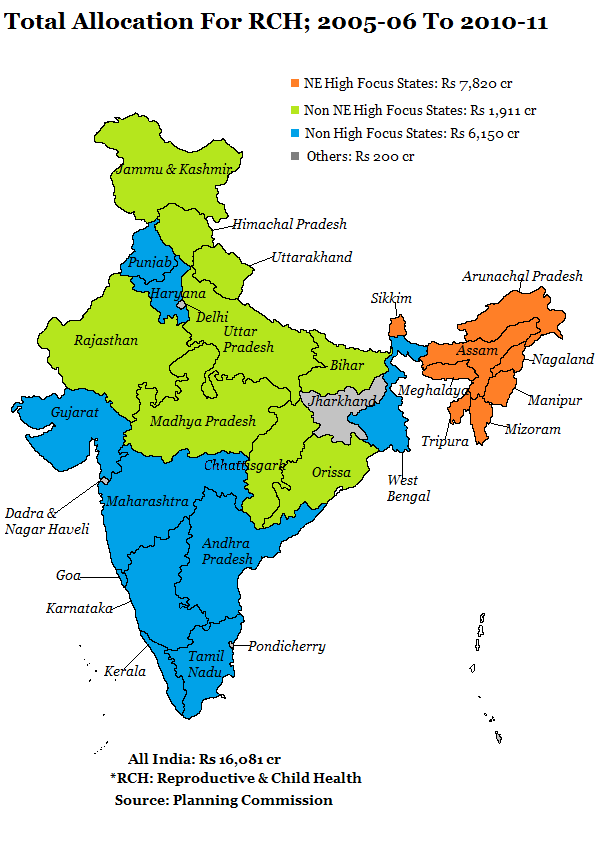Vitamin Supplements Could Help Children, If We Had Enough

| Highlights * Only 34% under-5 children received two full doses of vitamin A supplements in 2010 * While Assam had the highest vitamin A coverage of children at 72%, Uttar Pradesh had the lowest coverage at 37% in 2011 * Vitamin A administration is currently a government initiative, which is putting pressure on the public health machinery |
 While Assam had the highest coverage among the AHS states at 72%, Uttar Pradesh had the lowest coverage at 37.2%. The reasons cited for the poor performance in U.P include low level of awareness among parents, poor service delivery and lack of information. This is more or less true for almost all AHS states. The government has several programmes for vitamin A supplementation, and the following three are among the top featured ones: 1) The National Vitamin A Prophylaxis Programme Against Nutritional Blindness, 2) Reproductive and Child Health Programme under National Rural Health Mission (NRHM), and 3) Integrated Child Development Service (ICDS). The National Vitamin A Prophylaxis Programme, which was launched in 1976, is centrally-funded to provide vitamin A orally to children between ages of 1-5 years. The government tried to link the programme to the immunization schemes like the polio drive but met with limited success. The Planning Commission, Department of Family Welfare and the Indian Academy of Pediatrics feel that the polio programme was a success as the centers were manned by non-health workers but the same strategy could not be applied to vitamin A as there is chance of over dosage which could lead to death. While no financial details are available about the programme, it has managed to reach 43% children in 2005-06 (NHFSIII). Let us now look at the other interventions, Reproductive and Child Health Programme (RCH) and Integrated Child Development Service (ICDS). Figure 2
While Assam had the highest coverage among the AHS states at 72%, Uttar Pradesh had the lowest coverage at 37.2%. The reasons cited for the poor performance in U.P include low level of awareness among parents, poor service delivery and lack of information. This is more or less true for almost all AHS states. The government has several programmes for vitamin A supplementation, and the following three are among the top featured ones: 1) The National Vitamin A Prophylaxis Programme Against Nutritional Blindness, 2) Reproductive and Child Health Programme under National Rural Health Mission (NRHM), and 3) Integrated Child Development Service (ICDS). The National Vitamin A Prophylaxis Programme, which was launched in 1976, is centrally-funded to provide vitamin A orally to children between ages of 1-5 years. The government tried to link the programme to the immunization schemes like the polio drive but met with limited success. The Planning Commission, Department of Family Welfare and the Indian Academy of Pediatrics feel that the polio programme was a success as the centers were manned by non-health workers but the same strategy could not be applied to vitamin A as there is chance of over dosage which could lead to death. While no financial details are available about the programme, it has managed to reach 43% children in 2005-06 (NHFSIII). Let us now look at the other interventions, Reproductive and Child Health Programme (RCH) and Integrated Child Development Service (ICDS). Figure 2  Under RCH, the country has been divided into 4 parts: high-focus, north-eastern states (Arunachal Pradesh, Assam, Manipur, Meghalaya, Mizoram, Nagaland, Sikkim and Tripura), high focus, non- north-eastern states (Bihar, Chhattisgarh, Himachal Pradesh, J&K, M.P, Odisha, Rajasthan, U.P and Uttarakhand), non-high focus states (A.P, Goa, Gujarat, Haryana, Karnataka, Kerala, Maharashtra, Punjab, T.N and West Bengal) and rest of the country ( mostly union territories). The following map shows the funding received by each group: Figure 3
Under RCH, the country has been divided into 4 parts: high-focus, north-eastern states (Arunachal Pradesh, Assam, Manipur, Meghalaya, Mizoram, Nagaland, Sikkim and Tripura), high focus, non- north-eastern states (Bihar, Chhattisgarh, Himachal Pradesh, J&K, M.P, Odisha, Rajasthan, U.P and Uttarakhand), non-high focus states (A.P, Goa, Gujarat, Haryana, Karnataka, Kerala, Maharashtra, Punjab, T.N and West Bengal) and rest of the country ( mostly union territories). The following map shows the funding received by each group: Figure 3  So, it can be observed that the government is paying special attention to AHS states as they have some of the highest cases of vitamin A deficiency in the country. One of the major complaints is the lack of supply of vitamin A syrup to ‘anganwadi’ centers (under ICDS) and primary health care centers. Despite the government’s best efforts, vitamin A deficiency continues to be high and supplementation programmes are not yielding the desired results. The Planning Commission has suggested increasing Vitamin A consumption through food, either via better diet or food fortification. Vitamin A administration is currently a government initiative, which is putting pressure on the public health machinery in states like U.P where children don’t receive supplements. There are a growing number of NGOs working in the area (e.g. DSM and Vitamin Angels) to fill the gaps but they face a lot of local opposition due to lack of government support.
So, it can be observed that the government is paying special attention to AHS states as they have some of the highest cases of vitamin A deficiency in the country. One of the major complaints is the lack of supply of vitamin A syrup to ‘anganwadi’ centers (under ICDS) and primary health care centers. Despite the government’s best efforts, vitamin A deficiency continues to be high and supplementation programmes are not yielding the desired results. The Planning Commission has suggested increasing Vitamin A consumption through food, either via better diet or food fortification. Vitamin A administration is currently a government initiative, which is putting pressure on the public health machinery in states like U.P where children don’t receive supplements. There are a growing number of NGOs working in the area (e.g. DSM and Vitamin Angels) to fill the gaps but they face a lot of local opposition due to lack of government support.Next Story


